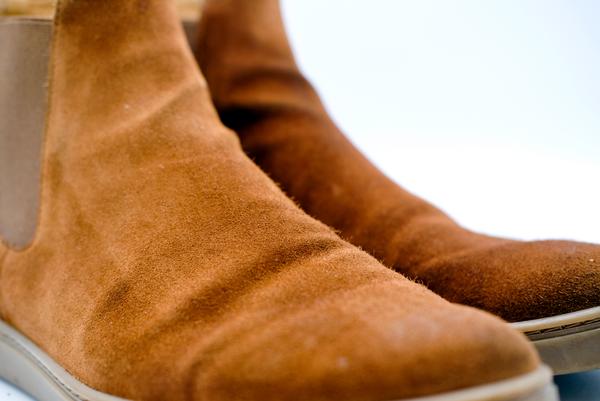Can you oil suede boot is a question that can attract many different answers. All backed with adequate proof. Considering suedes aren’t the cheapest shoes out there, it’s essential to maintain them for long periods. For the sake of every girl and guy out there who loves and appreciates their suede, we decided to go down the oily road and find out.
 After conducting our study, we have established that YES, it’s possible to oil suede boots provided the conditions are right. This means your shoes are starting to lose their natural color and need to be saved. You must also have the right products such as a suede brush, clean cloth and natural oil for the best results.
After conducting our study, we have established that YES, it’s possible to oil suede boots provided the conditions are right. This means your shoes are starting to lose their natural color and need to be saved. You must also have the right products such as a suede brush, clean cloth and natural oil for the best results.
It’s better to have a go at it first before rushing to someone else to do the job for you. Provided you know what is needed, you can have your boots looking as good as new in no time. It’s as simple as having several home products.
Before you begin, there are a few things you should take into consideration. For example, whether the boots are wet or dry. Having kept that in mind, read on to ensure you have the tips and tricks to save your boots and make sure they last longer.
When is the Appropriate Time to Oil Your Suedes?
The moment you notice that color has worn off, you should immediately consider oiling the boots. This should be done after a few days. At this time, the boots face minimal danger from the oil.
Oiling Your Suede Boots
Suede boots are the best, and most of us are found with the crime of continually wearing them. With time, the boots tend to fade away and lose their natural shine. Luckily there are steps you can take to ensure that luster is maintained. Choosing to oil your boots is one way to ensure the boots are maintained. However, this process is not without its shortcomings.
1.) Using Mink oil
Requirements:
| ITEMS | |
| 1. | Clean cloth or sponge |
| 2. | Mink oil |
| 3. | Suede brush |
Mink oil is one of the oils that can be used to bring the shine back to your leather. To ensure your boots are free of dirt, use the suede brush to get rid of any that may be on the shoes. Typically, the first point of contact on the shoe will be darker. You should, therefore, be strategic when applying the oil.
Dip the sponge into the oil, and begin at the tip of the toe while spreading to other areas of the shoe. This method will cater to the front of the shoe. Once done, work on the back of the shoe. The point of contact will be the heel.
Make sure to move in a circular motion while applying the oil for effective results. Repeat this process on both of the shoes. Take the suede brush again and gently brush the shoe. This will allow the mink oil to get deeper into the suede.
2.) Using Coconut oil
Requirements
| ITEMS | |
| 1. | Coconut oil |
| 2. | Vinegar |
| 3. | Water |
| 4. | Suede brush |
| 5. | Cloth |
The first step is to take a bowl and mix the vinegar and water. Ensure your boots are free of dirt, dip the cloth into the solution and wipe the shoes. Since the coconut oil is in its solid form, heat it to ensure it liquifies. Use your fingertips to apply the oil to your boots.
Apply the oil in circular motions. Once the application process is done, take the suede brush and shine the shoes. In case of excess oil, use the piece of cloth to get rid of it.
Coconut oil is one of the best alternatives as it is chemical-free and easy to apply. It is also among the cheapest oils, which make it affordable to most.
What are some other Alternatives?
In case you don’t have mink oil or coconut oil, other oils could work just as well as the two. They include; Vegetable oil, tartar cream, neatsfoot oil, jojoba oil, olive oil, and leather conditioners.
Why does using Oil Work?
When using oil to bring your shoes back to life, your shoes may turn a shade darker. This can serve as a good thing, particularly if your shoes had become entirely pale. Another reason why oil works for your shoe is the fibers get replenished, and the suede becomes flexible.
The oil also causes your boots to be water-resistant. With mildew issues with their boots, they will find the oil necessary as it prevents mildew, and in turn, the boots don’t rot.
Individuals who work in construction, farms, and other industries find oiling boots to be advantageous. They regularly use oil to maintain their boots. Their working environment causes them to apply friction on their boots continually.
This makes the boots dry up faster than most, and applying oil helps with reversing the damage. Other than acting as a repair mechanism, using oil helps protect the shoes from harsh weather conditions.
Why doesn’t Using Oil Work?
As much as oil has been recommended to bring that shiny look, some are against its use. The two primary reasons are that once the oil gets absorbed on the suede, it resurfaces after some time. Another reason is that oil spots form on some areas of the shoes. This gives it an unpleasant look.
The magic of oiling boots doesn’t apply to new suedes. You shouldn’t use oil on your suedes when they are still brand new. Only do this once the shoes start breaking out. The reason you should not do this is constant oiling could cause your boots to shrink. You should, instead, let the shoes get used to your feet and reshape naturally.
What to Do when Oil Accidentally Spills on your New Suedes?
Unfortunately, accidents do happen. You may unintentionally spill the oil on your boots before the actual process of oiling them. Fortunately, this is a situation that can be easily dealt with. There are several ways to handle this. Below is a list of ways you can save your boots before actually saving them.
1.) Use of a powder
Immediately the oil spills on your boots, pour some powder on the oil. After about an hour, you will realize the powder will become oily. Once this happens, use a shoe brush to wipe off the powder. Alternatively, you can let the powder stay on the shoe for several hours before you brush it off.
2.) Use of Dish soap
The moment the oil spills on the boots, take some paper towel and press them on the soiled area. The paper towel will absorb the excess oil on the boots. By doing this, you prevent the oil from getting deeper into the boot, forming a tougher stain. If you cannot wash the boots when they are soiled, ensure the oil has been soaked up.
Once done absorbing the excess oil, use a bar of dish soap to cover the stain for about 10 minutes. Most dish soaps help with eliminating oils, but having the grease-cutting kind is even better. Use the soap sparingly, as you will still be required to rinse everything off once done. It is important to note that suede is not a fabric that appreciates exposure to water. This method should, therefore, be used on small stains that have been pre-treated.
After covering the stain with soap, use a suede brush to scrub the stained area. If you don’t have a suede brush, you may use a toothbrush. Begin at the top of the stain as you brush downwards with light strokes. Avoid using too much energy when scrubbing, as this may cause damage to the suede. When done right, the fabric’s finish will look fresh and soft.
Use a damp cloth to wipe off the soap, preferably microfiber. Damp the cloth in lukewarm water and squeeze out excess water before wiping off the soap. If you are confident enough to get your suede wet, use running water to get rid of the soap. You can then air your shoe out, away from direct sunlight, so that it may dry.
3.) Use a Suede Cleaner
The first suede cleaner you can use is a suede eraser. These suede erasers are usually packed in suede care kits. They have similarities with pencil erasers. Clear the stain from top to bottom using the eraser. Repeat the process a couple of times until the eraser no longer seems to affect it.
The second way to get rid of the stain is by spraying suede cleaner on it. Most of the suede cleaners are available in spray bottles. Ensure you cover the stain with the cleaner. Direct the nozzle to the affected area and spray. If your suede cleaner isn’t in a spray bottle, measure a teaspoon of it, put it in a clean cloth, and spread it all over the stain. Household vinegar can also help in getting rid of the stain.
The Best Oils for the Best Results
Not every oil can be used on suede. For the best results, the best oil has to be used. The oil that is either sticky or heavy should therefore be avoided. This is because it settles on the pores and ends up damaging the shoes. The cast of oil that also forms on the shoe may become challenging to get rid of.
Features of the best suede oil
1.) Non-toxic and Natural blend oils
Your shoes run the risk of decreased lifespan if you use blends that are toxic or have chemicals in them. It would be best if you instead opted for natural oils.
2.) Waterproofing feature
As mentioned before, oils tend to make the boots waterproof. But this is not a feature provided by all types of oils. Only oils with beeswax and pine pitch can achieve this. With this additional feature, you get new looking boots and waterproof boots.
3.) Conditioning
The oil you use should be from a good brand. This way, the conditioning on your boots will last longer.
4.) Lightweight and Non-sticky
Non-sticky oil that is light in weight will guarantee you excellent results. With heavy oils, all you will get is an unpleasant patch on your boots.
How Often Should You Oil your Boots?
The frequency of applying oil on boots depends on the interest of the individuals. Those who use them for work need them regularly, unlike those who wear them once in a while. Regularly applying oil to your boots can be harmful to them.
The best amount of time to take before applying oil on your boots again should be every 2 weeks. If you let it exceed this time, your boots may begin to dull again.
What Happens when you Apply too much Oil?
When you apply too much oil on your boots after short periods, this will lead to your boots softening. This will, in turn, lead to the pores of your shoes clogging. This will prevent any ventilation from taking place. Your sweat/moisture will be accumulated, which will lead to bacterial growth. Your feet will end up stinking, and your shoes will be in trouble too.
If this happens to you, the most important thing to do is give your boots a soap wash. It would be best if you then used a diluted vinegar solution to clean the insides. After you do this, make sure to air them out on a sunny day to kill any remaining spores.
Summing Up!
When it comes down to it, oil is great for bringing your shoes back to life. Particularly if you have to wear boots daily, for as long as you don’t mind your shoes becoming a bit darker, you should undoubtedly give oils a go. Luckily, there is a variety to choose from. All you have to do is find one that works best for you.







